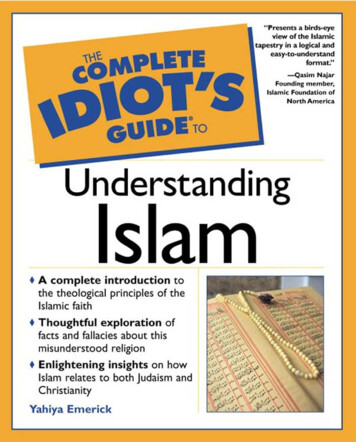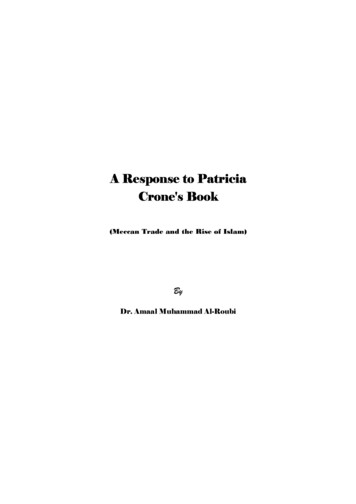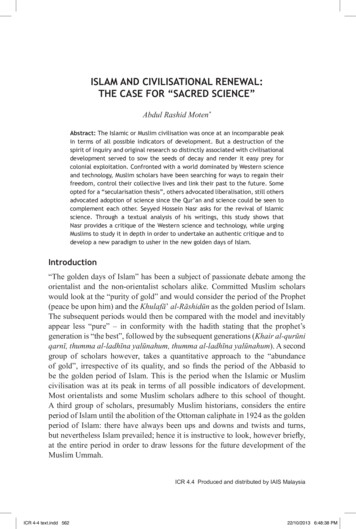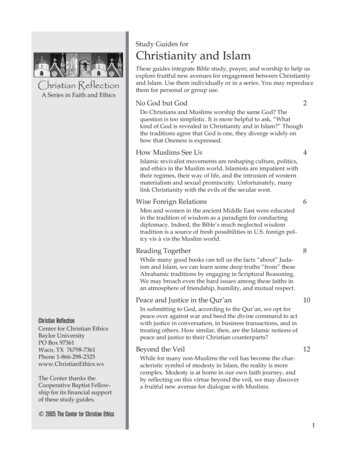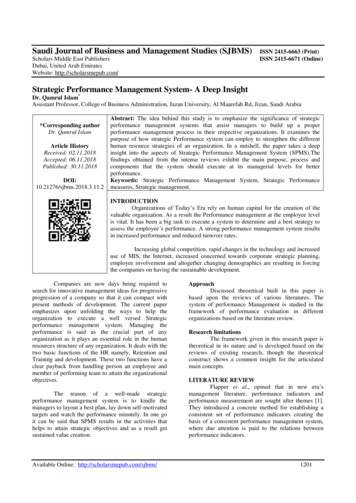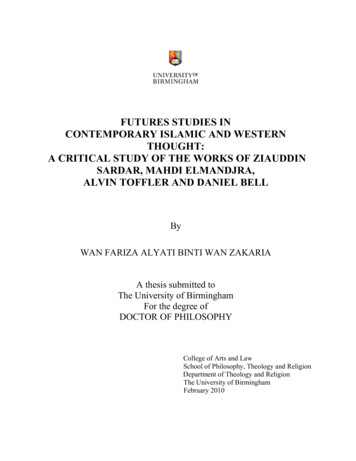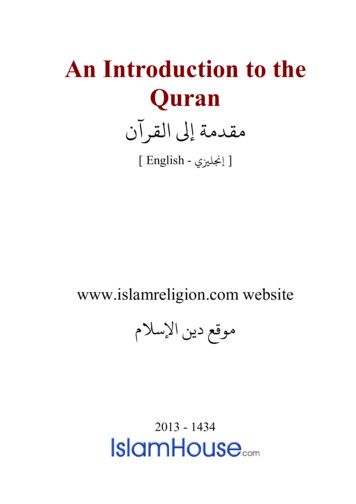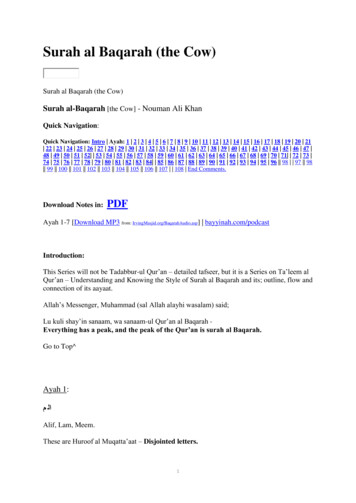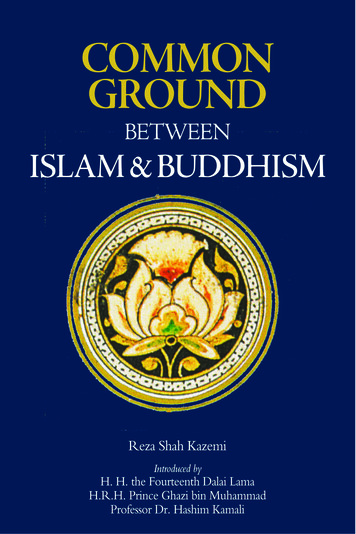
Transcription
Teaching Resources on Islam in World History/ Cultures and Geography coursesfor Elementary, Middle and High SchoolPresented by Susan Douglass, Affiliated Scholar, Council on Islamic Education, Fountain Valley, CA, andAcademic Coordinator of Education for Life, a Parent Cooperative supporting El-Iman Learning Center,Annandale, VAThe Council on Islamic Education (CIE), Fountain Valley, California, founded in 1990, is anational, non-profit research and resource organization comprised of Muslim academic scholarsof religion, history, political science, cultural studies, communications, and education, with aprofessional staff whose expertise relates to education, politics, media, and civic as well as faithcommunities in American society. CIE’s mission is to support and strengthen American publiceducation as the foundation for a vibrant democracy, a healthy civil society, and a nationally andglobally literate citizenry. CIE has worked with mainstream publishers and educationalorganizations, and engaged in teacher training across the nation, as well as publishing teachingresources. CIE maintains a web site at www.cie.org, with sections for the general public,publishers, journalists, and educators. The site features resources on teaching about Islam andMuslim history and culture, such as essays on world history, public education and teaching aboutreligion, and full text versions of various articles, reports, commentaries and news clips.Teaching and public services include basic information on Islamic beliefs and practices includingholidays, dictionaries of terminology, and a wide range of teaching resources and lesson plans,both for purchase and download.The Council on Islamic Education provides its services to public school educators andpublishers of school textbooks. During the past decade, CIE staff and Affiliated Scholars havereviewed and aided in the development of over a dozen textbooks in world history, worldgeography, US history and civics for elementary, middle and high school, as well as numeroussupplementary resource publications. The organization has conducted and published research oncurriculum and standards in social studies and related fields, including the study Teaching aboutReligion in National and State Social Studies Standards, co-published in 2000 by CIE and theFirst Amendment Center (www.fac.org). Related articles on this work have appeared inEducational Leadership, the journal of the Association for Supervision and CurriculumDevelopment (ASCD), Religion & Education, and Comparative Issues in ContemporaryEducation. A study of national and state world history standards is forthcoming.CIE’s work is also relevant to Muslim schools. Muslim schools often utilize curriculumbased on national standards which have heavily influenced state and local public schoolcurriculum, and they purchase textbooks used in public schools. Over a decade of workdeveloping supplementary resources reflects knowledge of curriculum across the US, as well asawareness of the gaps in coverage, and ways in which the study of Islam in history might beintegrated into world history and geography courses.The Council on Islamic Education has produced teaching resources which are available forpurchase and in many cases as free downloads. They are developed using the First AmendmentCenter Guidelines for Teaching about Religion, and strive for high levels of scholarship for theclassroom. These resources are appropriate for use in public, private, and Muslim schools, aswell as schools of other faith groups and in interfaith work.ISNA Education Forum 2005, Chicago ILSusan Douglass, Council on Islamic Education1
Teaching About World Religions in Standards and CurriculumAccording to a CIE/FAC study conducted in 2000, and still relevant today, teaching about allof the major world religions is not just permitted, but required in all state standards in worldcultures, world history and world geography courses. Most of these are concentrated at themiddle and high school levels (grades 612), but content on religions appears indiversity and community studies inelementary grades, and in US historyclasses. The framework for discussingreligious beliefs in textbooks andclassrooms should adhere to constitutionalguidelines that prevent either promotionor denigration of any faith. The heart ofsound coverage of world religions lies inportraying the beliefs and practices ofeach faith as their adherents understandand value them, not through secular orother filters. It is this aspect of theguidelines that ensures mutual respect andavoids phenomena such as the orientalism of the past century. Academics portrayed Islam, forexample, through the filter of their own beliefs and prejudices, making statements thatquestioned its veracity, even while pretending to accuracy, but in fact engaging in seriousdistortion of Islamic beliefs and practices. Muslim schools should also strive for accurateportrayal of other faiths, using attributive language—“Buddhists (or Hindus, Christians or Jews)believe that ”—as Muslims would have their own faith portrayed in the public arena, whatCharles C. Haynes of the First Amendment Center calls “learning about our deepest differences.”In terms of content on the world religions, standards for teaching world history within theframework of the constitutional guidelines can result in highly worthwhile learning experiencesfor all, based on excellent scholarship. CIE has been working toward this goal for over a decade.The new paradigms for teaching world history based on a global world view of the past—not onany centric view (whether Western orMuslim)—can truly educate students ofevery faith about the deeply held beliefsof each group, and about the history ofthe human spiritual experience.Education in world history hassuperceded the narrow view that oneculture’s experience should haveprimacy in the account, with all othersreduced to more or less marginal roles.A standards-based framework forteaching about the world religions doesnot proselytize, nor does it exoticize ordenigrate any faith. The role of religionsin world history is complex,geographically more diverse than the boundaries of any one civilization, and should be followedISNA Education Forum 2005, Chicago ILSusan Douglass, Council on Islamic Education2
over time, not frozen in an unchanging past. Finally, if teaching about religion is to have anylasting value for students, it should engage with the values and ethical foundations of thereligion, so as to establish a foundation for common humanity and work toward social justice forall. Only this way can we avoid the impression that learning about other faiths and cultures is justa matter of gathering more trivia about faraway people and places.Issues in Teaching World History and GeographyCurrent social studies courses and textbooks present a mixed picture. On one hand, textbooksfor middle and high school have not yet changed their structure enough to qualify as supportingrecent world history scholarship. Individual chapters and features have improved, but much moremust be done to bring them up to date with advances in world history scholarship. On the otherhand, major publishers’ textbooks for college courses do reflect this scholarship, and have beenauthored by leading world historians. The new Advanced Placement World History programs atmany high schools use these books, introducing their scholarship into secondary education.Through the College Board training programs, sponsored by grants from the NationalEndowment for the Humanities (NEH) and the World History Association (www.thewha.org),these courses have embraced a global view at the same time they have attracted tens of thousandsof new students and excellent scholar-teachers. Muslim high schools should look into teachertraining in AP world history, and develop overall programs that integrate teaching about Islamand Muslim history into this exciting new global framework. In world history courses throughoutthe country, students are learning about the important role Muslim societies played between the9th and 16th centuries as a huge region that fostered cultural exchanges in the eastern hemisphere.These advances in global history should be available in Muslim schools. Where textbooks fallshort, supplementary resources developed by CIE for use in middle and high school programsrepresent an effort to bring this scholarship to younger students as well. Development of theseteaching resources, which are featured on the next pages, are based on these objectives:1. To prepare student-ready lessons on Islam and Muslim history that meet the objectives ofworld history and geography courses for middle and high school, that provide accurateinformation based on good scholarship. The approach is to provide a level of evidenceand tools for learning that are based on acquiring historical thinking skills.2. To help students understand the development of Muslim civilization in a global historicalcontext, including contributions from earlier and contemporary civilizations such asIndia, Persia and China. Lessons should bring understanding of complex historicalprocesses like the spread of Islam, the rise of cities and trade, and the role of scholarlyclasses in spreading and unifying Muslims.3. To make primary sources available to students and teachers in secondary classrooms,which would otherwise be available only to specialists. These teaching units featureMuslim literary culture, the development of the sciences and arts, and the role of Muslimcivilization as an engine of trans-hemispheric cultural, economic and knowledgeexchange. Thorough citation of sources, and development of teaching activities that helpstudents engage with the material, are part of each unit.4. To address issues and challenges relevant to contemporary Muslim societies, bringingcurrent knowledge and discussion into the classroom. Bringing evidence and argument,stimulating discussion and analysis.ISNA Education Forum 2005, Chicago ILSusan Douglass, Council on Islamic Education3
Descriptions of CIE Teaching Resources available at www.cie.orgTeaching About Islam and MuslimsThis is the third edition of CIE’s popular handbook for teachers,and contains a straightforward, concise introduction to Islamarranged in Question & Answer format. The publication alsoincludes a useful guide to the religious needs of Muslim studentsfor which schools can provide legal accommodation, a list ofrecommended books, videos and other materials, and a glossaryof terms.This and all CIE resources are listed on the CaliforniaDepartment of Education’s "Instructional MaterialsApproved for Legal Compliance."Beyond a Thousand and One Nights: A Sampler ofLiterature from Muslim CivilizationDiscover this rich and varied collection of Muslim literature,compiled specifically with teachers in mind. Types of primary sourceliterature represented include historical writing, travel literature,scientific writing, folktales, and poetry, among others. Eachselections is accompanied by critical-thinking questions,illustrations using artworks from the period and suggestions forstudent activities. Pages are reproducible and wire-bound for easycopying. Let African scholar al-Jahiz tell why paper is better than parchment,written just when that Chinese innovation was being adopted inAbbasid Baghdad. Read a page from Ibn Rushd’s (Averroes) commentary on Aristotle, a work that Thomas Aquinasread by candlelight, and get medical advice from al-Razi. Let al-Khwarizmi introduce the new branch of mathematics called al-jabr (algebra), with formulasand word problems written in the 9th century, and learn why al-Biruni studied shadows. Read beautiful lyric poems from Spain that became part of the romantic, chivalric tradition ofmedieval songs, and get plans for building a mechanical lamp and water fountain. Laugh as you learn the simple wisdom of Goha, the universal "Charlie Chaplin" figure known acrossthe Muslim world, and ponder deep questions raised by Muslim philosophers. Follow Muslim geographers, scientists and travelers as they introduce chess and backgammon,make a pilgrimage to Makkah, and take a tour of 10th century Baghdad with one of its famousresidents. Find out what Egyptian scholar al-Jabarti thought of Napoleon’s invasion, and how the Syrian knightUsama viewed the Frankish crusaders.ISNA Education Forum 2005, Chicago ILSusan Douglass, Council on Islamic Education4
The Emergence of Renaissance: Cultural Interactionsbetween Europeans and MuslimsThis collection of teaching resources was over five years inthe making, and has inspired numerous presentations atconferences, universities and museums. It was inspired by thedesire to show students, not just tell them, how Muslim advancesin arts and sciences, technology, education, travel and tradestimulated developments in Europe from the 12th century onward.From hemispheric trade to the history of science, from art,literature and architecture to luxury consumer goods, and fromreligious expression to the rise of colleges, The Emergence ofRenaissance lets students hear the voices and see the sights ofplaces, people and fascinating artifacts that contributed to thisformative period in Western and world history.Covering learning standards related to medieval and Renaissance world history fromvirtually every state and national curriculum document, this flexible teaching tool containsdozens of illustrated texts, activities, literature and primary source readings. Teachers canutilize the materials for lecture preparation, for in-depth exploration of history in cooperativelearning settings, and for student reading and classroom activities. The complete collectioncan be a mini-course or teachers can use the four segments separately, or select lessons andactivities. A chart keys texts and activities to topics in the world history course, helping theteacher to select the right materials for middle school, high school, or mixed ability students.Useful in science, math, and art classes, too. 350 pages, with a CD image disk to accompanyslide show lessons.Muslim HolidaysThis new edition of the teaching resource contains a guide forteachers that describes the religious needs of Muslim studentspertaining to Muslim holidays. The publication also includesstudent readings for primary, elementary, and middle/high schoollevels, along with discussion questions and suggested activitiesfor students. Students learn why Ramadan and the Hajj areimportant to Muslims, and how they celebrate the associatedholidays: Eid al-Fitr, the festival of breaking the fast, and Eid alAdha, the festival of sacrifice. Students also learn about theimportance of Friday as a day of congregational worship andcommunity interaction, and about other important dates in theIslamic calendar.References to these CIE teaching resources are also featured in lessons from the freedownloadable online curriculum for world history entitled World History for Us All athttp://worldhistoryforusall.sdsu.edu/.ISNA Education Forum 2005, Chicago ILSusan Douglass, Council on Islamic Education5
Primary Source Lesson Sets produced by CIE for the National Centerfor History in the Schools at UCLAThe Crusades from Medieval European and MuslimPerspectivesThis unit provides a first-hand look, through historicalprimary sources, at the various types of culturalinteractions that took place during the Crusades. Thisresource is on the California Department of Education’s"Instructional Materials Approved for Legal Compliance"list. Lesson topics include: Crusaders Living in Muslim Lands Crusader Meets Mujahid: The Military Encounter Salah al-Din (Saladin): An Ideal Muslim Leader Ideals and Motivations for the Crusades, and theMuslim Response Glimpses of Women’s Experiences During theCrusadesImages of the Orient: European Travelers to Muslim LandsThis unit provides a first-hand look, through historical primarysources, at the experiences of Europeans traveling to distantlands during the era of industrialization. Students gain insightinto how the works of these travelers influenced the perception ofIslam and Muslims in Europe from the nineteenth centuryonwards. Lesson topics include: Pilgrims and Tourists Colonial Officials Archaeologists and Antiquarians Political Figures Artists, Architects, and Photographers Literary Figures.Muslim Women Across the CenturiesThis unit, developed by CIE and co-published by the NationalCenter provides a first hand look, through historical primarysources, at the rights accorded to women by Islam, at howgender issues were actually addressed in classical Muslimsociety, and at the diverse roles that Muslim women playedhistorically. Lesson topics include: Women’s Rights and Protections in Islam Gender Roles and Women’s Identities in Muslim Society Muslim Women Leaders Through the Centuries Famous Muslim Women as Role Models.ISNA Education Forum 2005, Chicago ILSusan Douglass, Council on Islamic Education6
www.theIslamProject.orgLesson Packet for Muhammad: Legacy of a ProphetThese lessons were designed to help teachers make the most of viewing the documentary film in the classroom, inconnection with basic content on Islam and Muslims in world geography/cultures and world history or US history courses. Pre-viewing Vocabulary ActivityStudent Note-taking GridsGeography and History of the Arabian Peninsula and Overview of IslamBiographical Sketch of Muhammad's LifeBiographical Notes on the Experts in the FilmSequencing Events in Muhammad's LifeKey Figures in Muhammad's LifeThe "Constitution of Madinah" and the Mayflower CompactThree Major Events in the Rise of IslamThe "Battle of the Trench" and the Concept of Treason in Comparative LawThe Concept of Prophethood in IslamPersonal and Civic Values in IslamAmerican Muslim Responses to September 11, 2001Lesson Packet for Frontline: MuslimsThese lessons make the most the film, in world geography/cultures and world history or US history classroom, providingcontext for the scenes from a variety of contemporary Muslim societies. Pre-Viewing Vocabulary Activity Student Note-taking Grids & Critical Thinking QuestionsThe Life of Muhammad: Geography and History of the Arabian Peninsula, and Overview ofIslam (Map & Background Info)A reading and map explain Arabia and its historical importance, with an overview of basic beliefsand practices, and a chart shows how the Five Pillars and their many dimensions relate to Muslimcivilization.Critical Thinking about Terminology Related to Islam and MuslimsThis lesson helps students critically evaluate some of the phrases and concepts used to describe Islam and Muslims.Biographical Sketch of Muhammad's LifeOverview of Muslim History and the Spread of Islam from the 7th to the 21st CenturyThe Geography & Cultures of Muslim Countries This lesson features hands-on projects for students that help them learnabout the Muslim country of their choice.Values and Practices of the Faith Analyze comments by individuals concerning faith, family and community, unity anddiversity, American society, and extremism.The Masjid in the American Landscape: Civic Rights Students explore the relevant civic issues and rights, and considerthe role of interfaith dialogue as a means to achieve greater understanding between groups of Americans as Muslims seek tobuild a masjid (mosque) in Palos Heights, IL.What is Shariah? Major Sources and Principles of Islamic Law Background reading on the nature of Islamic law, theprocess of making a legal judgment, and the role of legal scholars in Muslim history.Comparative Document Study--Human Rights and Religious Tolerance in Islam and in the French and AmericanEnlightenment Traditions Studyand compare three primary sources quoted from Thomas Jefferson, the French Declarationof the Rights of Man, the Qur'an and Hadith.Women's Rights and Marriage in Islam Students contextualize the film's content about women's rights, including marriageand divorce. Students compare Islamic teachings and ideals with the practice of Muslims in various cultural and nationalsettings.Secularism in Comparative Perspective: The Hijab as Case Study in Three Countries Readings and press coverage onMuslim women and headscarves in three countries helps students explore secularism and its relationship to religious freedom.Making Sense of Jihad vs. Hirabah (Terrorism) Explanation of the Islamic concept of jihad is distinguished from hirabah, aterm used by Muslim jurists for unlawful acts of public violence that today would be labeled "terrorism," showing the and legalcondemnation of terrorism.ISNA Education Forum 2005, Chicago ILSusan Douglass, Council on Islamic Education7
publishers of school textbooks. During the past decade, CIE staff and Affiliated Scholars have reviewed and aided in the development of over a dozen textbooks in world history, world geography, US history and civics for elementary, middle and high school,
